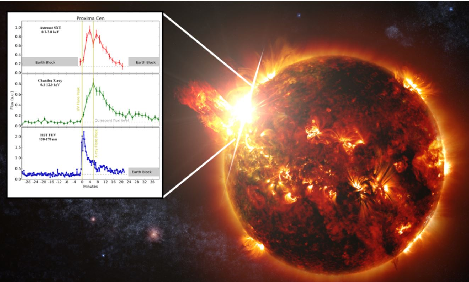A new discovery by India’s space telescope, Astrosat, dashes hopes of alien life on our nearest stellar neighbour, Proxima Centauri. Highly energetic flare simultaneously observed by Astrosat and NASA’s space telescopes on Proxima means it is not habitable as was believed so far.
A new discovery by India’s space telescope, Astrosat, has dashed hopes of alien life on our nearest stellar neighbour, Proxima Centauri. Highly energetic flare simultaneously observed by Astrosat and NASA’s space telescopes on Proxima means it is not habitable as believed till now.
Astronomers say the strong flare observed on Proxima Centauri on May 31 rules out alien life on this exoplanet. “It makes it highly iprobable for earth like life forms to exist there, unless we find special radiation resistant life forms” observed Prof. K.P. Singh of Tata Institute of Fundamental Research (TIFR), Mumbai, who was involved in the discovery.
Proxima Centauri, the nearest exoplanet discovered till date, is not much larger than the Earth and is mostly likely a rocky planet. It has been orbiting in the so-called “habitable zone” that astronomers think could harbour life. Some even ventured to claim that perhaps the first alien we would encounter would come from this planet.
All such hopes were dashed on 31 May when joint observation by Astrosat along with Chandra X ray space telescope, Hubble Space Telescope, and a ground-based observatory High Accuracy Radial velocity Planet Searcher (HARPS) observed a very intense flare resulting from an explosion on its surface.
The star is known to flare often, but the flare that was observed in May lasted for about 1800 seconds and released energy in the order of 1030 erg. “The typical energy released during a solar flare is of the order of 1026-28 erg. That means this flare is hundred times that of those seen on the Sun,” pointed out Prof Singh. “If a flare like the one observed on Proxima Centauri occurs on our Sun it might disrupt power grids, broadcast and electricity on the earth and also affect astronauts in space.”
Powerful and frequent flaring events, as seen on Proxima, may produce large radiations and particles which may significantly influence its atmosphere habitability, according to Prof Jürgen Schmitt, another member of the research team.
The hefty flare observed on the surface of Proxima Centauri spewed a dash of strong X rays and far-UV rays, ten times the normal, bathing the planet in a rain of deadly radiation. “The high-energy photons like the UV and X-ray photons are absorbed by the planetary atmosphere heating it to 10s of 1000s of Kelvin affecting the capability of the planet to sustain its atmosphere and in particular to sustain water in liquid form,” pointed out Dr. Lalitha Sairam of Indian Institute of Astrophysics, Bengaluru.
Not more than five to ten times the mass of Earth, revolving around a star just 12% as massive as our Sun and 0.1% as bright, Proxima Centauri may not be that appealing. Given an orbital period of just 11 days, the exoplanet was thought to be warm enough but not close by to be scorching hot. The host star, Proxima Centauri, is joined by stars Alpha Centauri A and B, 15000 astronomical units (AU) away in creating a multi-star system. Thus from the planet, one would have been able to see three ‘suns’ floating in the sky. All would be fine if these stars were well behaved. But it is known that Proxima Centauri flares frequently.
In ‘cool dwarfs’ like Proxima Centauri, as a result of fluctuating magnetic reconnection on its surface, large amount energy and ionic particles are released all around. Such events called as “flaring” can have timescales of few minutes to hours.


